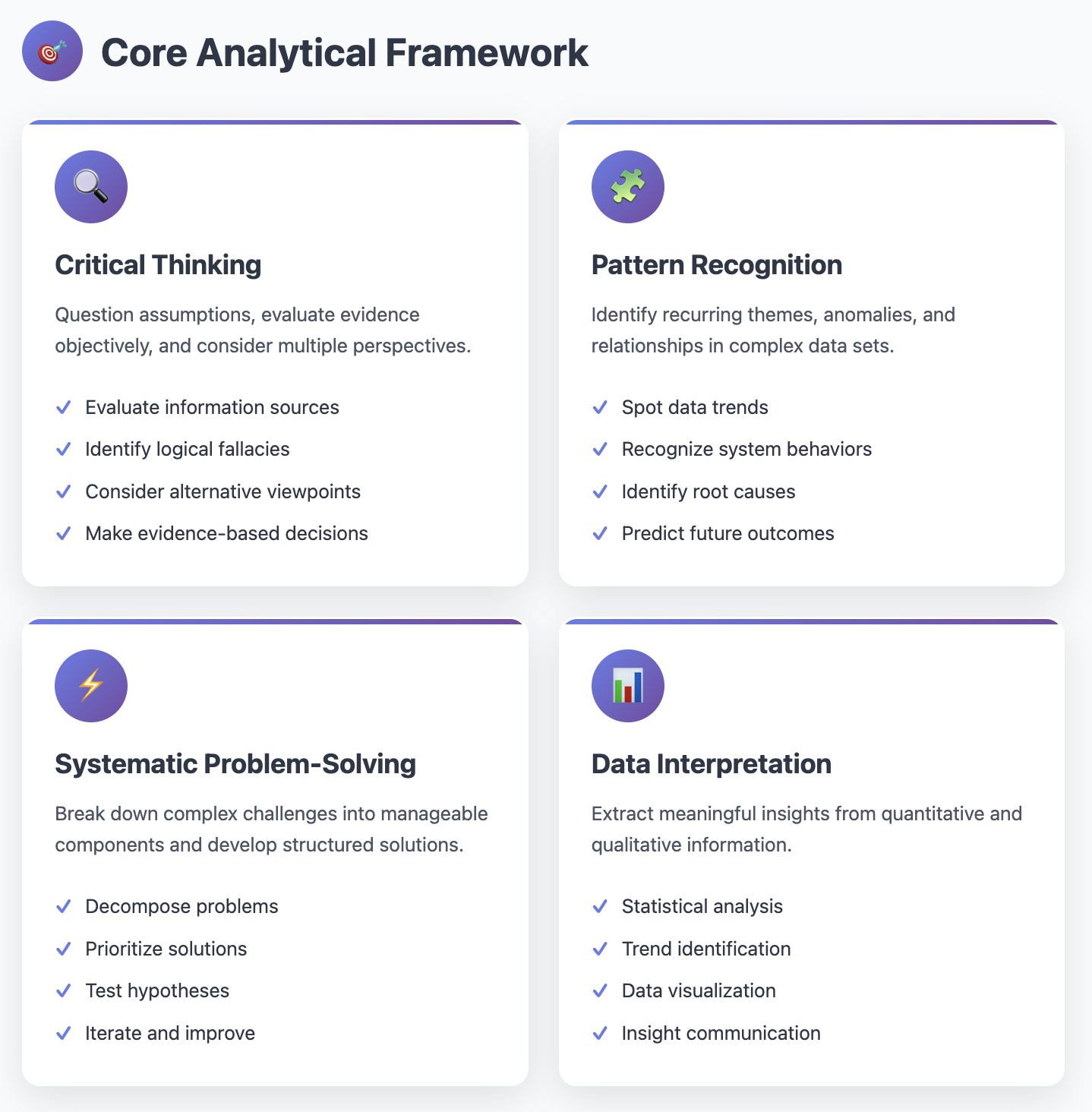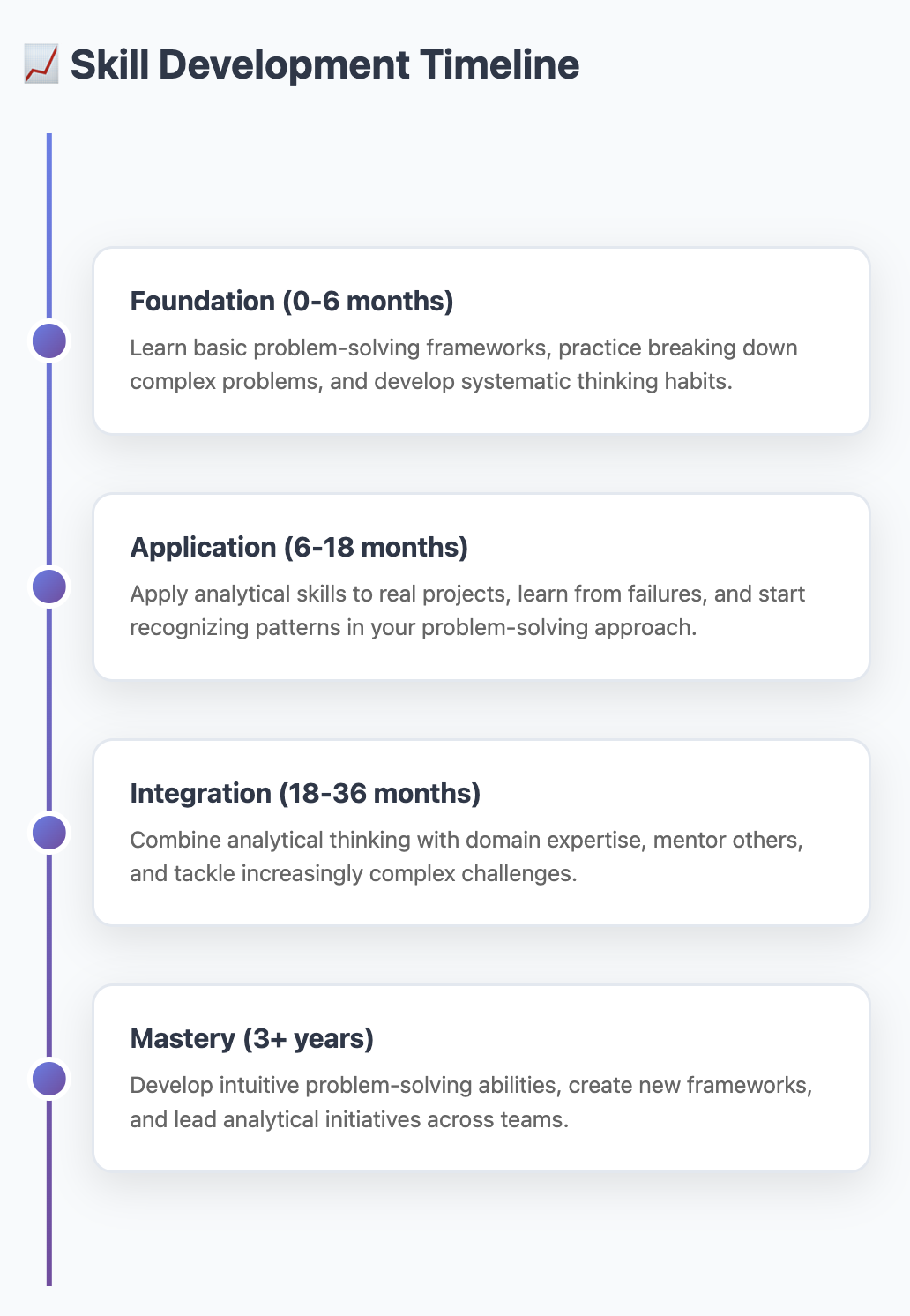.jpeg)
Modurotolu Olokode
Modurotolu Olokode is a seasoned full-stack engineer with a decade of experience in building scalable applications. Modurotolu is passionate about solving problems with technology and loves sharing insights that empower developers to make informed technical decisions.
Article by Gigson Expert
Analytical thinking is a cornerstone of professional success in the technology ecosystem. While technical skills get you through the door, your ability to analyze complex problems and make informed decisions propels your career forward. Understanding how to cultivate and apply analytical skills can transform an average tech professional into a highly valued asset.
The Foundation of Analytical Thinking
Analytical thinking means approaching problems methodically. It involves:
- Breaking complex challenges into manageable parts
- Identifying patterns across data sets
- Understanding cause-and-effect relationships
Critical thinking underpins this process. Great tech professionals question assumptions, examine evidence objectively, and consider multiple angles before making decisions, especially in high-stakes environments where choices affect product integrity, user experience, or system reliability.
Pattern recognition is also key. Whether debugging a system crash, analyzing customer churn, or investigating API performance, recognizing recurring behaviors and outliers sharpens your instincts and efficiency.

Practical Application in Daily Work
Analytical skills surface differently across disciplines. Here's how they show up in day-to-day tech work:
Software Developers
- Debugging complex code paths
- Optimizing algorithms for speed and memory
- Making architecture decisions based on performance benchmarks
Data Analysts & Scientists
- Extracting insights from large datasets
- Building predictive models
- Communicating findings through dashboards or reports
Product Managers
- Analyzing user feedback and feature adoption
- Prioritizing the roadmap using both data and intuition
- Testing product hypotheses through A/B testing or cohort analysis
DevOps Engineers & System Administrators
- Analyzing logs and metrics (e.g., via Datadog, Prometheus, ELK stack)
- Identifying failure patterns and preventing incidents
- Ensuring uptime through capacity planning and automation
Example: A product manager noticed a drop in user engagement after a redesign. Instead of reverting the changes blindly, they used heatmap analytics (via Hotjar), correlated it with usage logs, and discovered navigation confusion. The fix? A simplified menu that boosted engagement by 22%.
Developing Your Analytical Toolkit
Building strong analytical abilities requires deliberate practice and continuous learning. Start by cultivating curiosity about how things work. When you encounter a problem, don't just apply a quick fix; dig deeper to understand the underlying cause. This mindset builds stronger analytical habits.
Practice data interpretation regularly. Work with datasets relevant to your field, even if it's not part of your current role. Learn to identify trends, outliers, and correlations. Understanding basic statistics and data visualization techniques enhances your ability to communicate insights effectively.
Embrace experimentation and hypothesis testing. Form theories about why certain issues occur or how improvements might be achieved, then test these hypotheses systematically. This scientific approach to problem-solving builds confidence in your analytical conclusions.
Seek feedback on your analytical processes. Share your problem-solving approaches with colleagues and mentors. Different perspectives can reveal blind spots in your thinking and suggest alternative analytical frameworks.
Key Actions
- Analyze one dataset weekly
- Debrief every major problem you solve: What went well? What was missed?
- Read one article a week on cognitive science or logic (e.g., from Farnam Street or LessWrong)

Advanced Analytical Strategies
Once foundational skills are in place, deepen your abilities with more strategic techniques:
Systems Thinking
Understand how components interconnect in broader ecosystems. Changing one element in a system (e.g., a database index or user onboarding flow) often has ripple effects elsewhere.
Combine Quantitative & Qualitative Analysis
- Use metrics to validate direction, but interpret user sentiment, business context, and intuition to refine execution.
- Example: Low click-through doesn’t always mean bad UX—it might reflect unclear copy.
Scenario Planning
Use decision trees or tools like Monte Carlo simulations to map multiple outcomes and assign probabilities. This helps you anticipate unintended consequences.
Use Cognitive Models
- Apply First Principles Thinking to break assumptions.
- Consider Bayesian Thinking for updating beliefs with new evidence.
- Learn to spot cognitive biases (confirmation bias, anchoring, sunk-cost fallacy) in your problem-solving process.
Communicate Your Findings Clearly
Even the best analysis fails if no one understands it. Tailor your message:
- For executives: Focus on impact and risk
- For peers: Include data, models, and trade-offs
- Use visuals (e.g., charts, timelines, impact matrices) to tell the story
Long-term Career Impact
Strong analytical abilities create a compound effect on career growth. They enable you to identify opportunities others miss, solve problems more efficiently, and make decisions that stand the test of time. As you progress in your career, these skills become increasingly valuable for strategic thinking and leadership roles.
Analytical thinkers often become the go-to problem solvers in their organizations. This reputation leads to greater responsibilities, challenging projects, and career advancement opportunities. Moreover, analytical skills are transferable across different tech domains, providing career flexibility as technology evolves.

Frequently Asked Questions
Q: How can I improve my analytical thinking if I'm naturally more creative?
A: Creativity and analytical thinking complement each other beautifully. Use your creative mindset to generate multiple hypotheses and solutions, then apply analytical techniques to evaluate which options are most viable. Many breakthrough innovations come from combining creative insight with rigorous analysis.
Q: What tools should I learn to enhance my analytical abilities?
A: Start with Excel or Google Sheets for basic data analysis, then progress to SQL for database queries. Learn a programming language like Python or R for more advanced analytics. Visualization tools like Tableau or Power BI help communicate insights effectively.
Q: How do I know if my analytical skills are improving?
A: Look for signs like solving problems faster, identifying patterns others miss, making more accurate predictions, and receiving recognition for your problem-solving abilities. You'll also notice increased confidence in tackling complex challenges.
Q: Can analytical skills be learned, or are they innate?
A: While some people may have natural analytical inclinations, these skills can be developed through practice. The key is consistent application, seeking feedback, and gradually tackling more complex problems.
Q: How important are analytical skills compared to technical skills?
A: Both are crucial, but analytical skills often determine how effectively you can apply technical knowledge. Technical skills get you hired, but analytical abilities drive career advancement and leadership opportunities.
Q: What's the difference between analytical thinking and critical thinking?
A: Critical thinking focuses on evaluating information and arguments objectively, while analytical thinking involves breaking down complex problems into components. Both are important, and they often work together in problem-solving scenarios.




